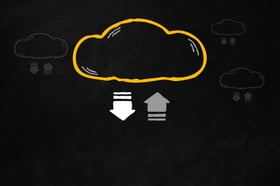
Software defined storage (SDS) has the potential to revolutionize your business processes and drive extraordinary value. However, storage isn’t just measured by capacity. In our previous blog post, we laid out the example of thinking of your organization’s storage infrastructure like a virtual city: there are specific places designated for each type of data, from highly-utilized information to archives. Because of this, there is a true need for segmenting your resources; today, SDS is finally allocating true Automated Storage Tiering (AST) for enterprises. AST has created a natural and timely partnership with flash storage to offer the speed and performance that personal computing devices have enjoyed for years and many organizations are now considering all-flash based arrays to meet the demands of server virtualization.
The Case for Tier Separation
The SDS market is expected to grow from $1,409.7 million in 2014 to $6,217.6 million by 2019, at an estimated compound annual growth rate of 34.6 percent from 2014 to 2019. Your organization creates and demands all types of data, and each of these data classes summons different demands from your storage infrastructure. To meet these needs, your data infrastructure should be separated into multiple tiers.
For example, one type of data may require (and justify) incredibly high performance, no matter the cost, while other data classes only require modest performance at a reasonable cost. On the other end of the spectrum, long-term retention data and archived information can settle for minimum levels of performance.
A possible example of an Automated Storage Tiering design could look like this:
- Tier 0: Flash Storage.
- Tier 1: Production storage (prior to Flash storage, this used to be the top tier). High value data that is regularly utilized should reside here.
- Tier 2: Intermittent storage. Low cost/performance disks can be implemented for data that is only accessed every so often.
- Tier 3: Tape storage, which is necessary for required archives with strict government and industry regulations.
The idea of Automated Storage Tiering in an SDS environment is nothing new; it has been around for decades, but has previously lacked the intelligence mechanism to optimally implement it. Up until now, storage was assigned by age or some similar determinate that provided a best guess at tier assignments. Today, SDS systems use sophisticated algorithms that calculate usage and relative demand of data chunks. Then, data can be elevated or demoted between the available tiers.
Cloud Computing Makes Automated Storage Tiering Possible
The cloud is creating even greater opportunities for AST as more organizations are employing cloud-based storage. Cloud service providers and vendors are now offering storage devices that serve as a front-end storage appliance for the cloud. Rather than moving data between different physical hardware, these appliances shuffle data between local direct attached storage (DAS) locations and the cloud. They can also provide large caching depositories for data that is being saved off-premise.
The decisions organizations make are only as good as the data that is used to formulate them. We are in an era where the value of a company can be directly attributed not only to the value of its data, but the ease of its accessibility, and the capability and aptitude to analyze and process it. The decoupling of software from hardware is opening the door for new innovations and is giving IT managers the levels of data management and cost control that up until recently was only imaginable.
The benefits and value of SDS is being recognized by top industry leaders and future tech disruptors. Do you think it’s time for your organization to embrace SDS as well?
Read the white paper, Managing your Data with Software Defined Storage to learn more, then contact us here to discuss which SDS solution is right for your business.










